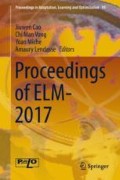Abstract
Aiming at the accuracy prediction of combustion efficiency for a 300 MW circulating fluidized bed boiler (CFBB), a online sequential circular convolution parallel extreme learning machine (OCCPELM) is proposed and applied to build the models of boiler efficiency. In OCCPELM, the circular convolution theory is introduced to map the hidden layer information into higher-dimension information; in addition, the input layer information is directly transmitted to its output layer, which makes the whole network into a double parallel construction. Four UCI regression problems and Mackey-Glass chaotic time series are employed to verify the effectiveness of OCCPELM. Finally, this paper establishes a model of combustion efficiency for a CFBB. Some comparative simulation results show that OCCPELM with less hidden units owns better generalization performance and repeatability.
Access this chapter
Tax calculation will be finalised at checkout
Purchases are for personal use only
References
Schoukens, J., Pintelon, R.: Identification of Linear Systems: A Practical Guideline to Accurate Modeling. Pergamon Press, Oxford (1991)
Antoulas, A.C.: An overview of approximation methods for large-scale dynamical systems. Annu. Rev. Control. 2, 181–190 (2005)
Green, M., Ekelund, U., Edenbrandt, L., et al.: Exploring new possibilities for case-based explanation of artificial neural network ensembles. Neural Netw. 22, 75–81 (2009)
Iliya, S., Goodyer, E., Gow, J., et al.: Application of Artificial Neural Network and Support Vector Regression in cognitive radio networks for RF power prediction using compact differential evolution algorithm. In: Federated Conference on Computer Science and Information Systems, pp. 55–66. IEEE press (2015)
Wang, S., Chung, F.L., Wang, J., Wu, J.: A fast learning method for feedforward neural networks. Neurocomputing 179, 295–307 (2014)
Huang, G.-B., Zhu, Q.-Y., Siew, C.-K.: Extreme learning machine: theory and applications. Neurocomputing. 70, 489–501 (2006)
Huang, G.B., Zhu, Q.Y., Siew, C.K.: Extreme learning machine: a new learning scheme of feed forward neural networks. In: 2004 IEEE International Joint Conference on Neural Networks, pp. 25–29. IEEE press, New York (2004)
Huang, S., Wang, B., Qiu, J., et al.: Parallel ensemble of online sequential extreme learning machine based on MapReduce. Neurocomputing. 174, 352–367 (2016)
LeCun, Y., Bottou, L., Orr, G.B., Müller, K.P.: Efficient backprop. LNCS, vol. 1524, pp. 9–50 (2002)
Platt, J.: A resource-allocating network for function interpolation. Neural Comput. 3, 213–225 (1991)
Liang, N.Y., Huang, G.B., Saratchandran, P., et al.: A Fast and Accurate Online Sequential Learning Algorithm for Feedforward Networks. IEEE Trans. Neural Networks 17, 1411–1423 (2006)
Lima, A.R., Cannon, A.J., Hsieh, W.W.: Forecasting daily streamflow using online sequential extreme learning machines. J. Hydrol. 537, 431–443 (2016)
Zhang, J., Feng, L., Yu, L.: A novel target tracking method based on OSELM. Multidimens. Syst. Signal Process. 1–18 (2016)
Gao, X.Q., Ding, Y.M.: Digital Signal Processing. Xidian University Press, Xi’an (2009)
Wang, J., Wu, W., Li, Z., et al.: Convergence of gradient method for double parallel feed forward neural network. Int. J. Numer. Anal. & Model. 8, 484–495 (2012)
Acknowledgements
This work was supported by the National Natural Science Foundation of China [Grant No. 61403331, 61573306], the Natural Science Foundation of Hebei Province [Grant No. F2016203427], the China Postdoctoral Science Foundation [Grant No. 2015M571280], the Doctorial Foundation of Yanshan Univerity [Grant No. B847], the natural science foundation for young scientist of Hebei province [Grant No. F2014203099] and the independent research program for young teachers of yanshan university [Grant No. 13LG006].
Author information
Authors and Affiliations
Corresponding author
Editor information
Editors and Affiliations
Rights and permissions
Copyright information
© 2019 Springer Nature Switzerland AG
About this paper
Cite this paper
Li, G., Chen, B., Qi, X., Zhang, L. (2019). Model Research on CFBB’s Boiler Efficiency Based on an Improved Online Learning Neural Network. In: Cao, J., Vong, C., Miche, Y., Lendasse, A. (eds) Proceedings of ELM-2017. ELM 2017. Proceedings in Adaptation, Learning and Optimization, vol 10. Springer, Cham. https://doi.org/10.1007/978-3-030-01520-6_12
Download citation
DOI: https://doi.org/10.1007/978-3-030-01520-6_12
Published:
Publisher Name: Springer, Cham
Print ISBN: 978-3-030-01519-0
Online ISBN: 978-3-030-01520-6
eBook Packages: Intelligent Technologies and RoboticsIntelligent Technologies and Robotics (R0)

